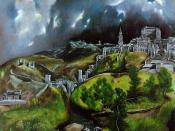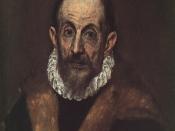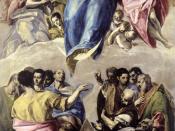El Greco is the name of one of Mannerism's most well-known artists. Born in 1541 as Domenikos Theotokopoulus on the island of Crete, El Greco's paintings represented a change from naturalism to mannerism.
Crete was a dependency of Venice, so it is highly likely that El Greco moved to Venice to pursue art studies. He remained in Venice from August 1568 to the fall of 1570, when he moved to Rome. While tradition holds that he was an apprentice of Titian, this is highly unlikely, even though his works were influenced by the colors and 'free handling of paint' by the artists in Venice.
In Rome, El Greco resided for sometime at the Farnese Palace, where he met Fulvio Orsini. Orsini influenced him with his belief that art and scholarship went hand in hand, and he was admitted in to the Academy of Saint Luke.
Unfortunately, records indicate that El Greco fell into disfavor in Rome when he offered to repaint a portion of the ceiling of the Sistine Chapel, originally painted by Michelangelo.
Following this, he signed a contract in 1576 to paint altarpieces for the church of Santa Domingo el Antiguo, in Toledo. By September 1579, he had completed nine paintings for the church, a series known as the Disrobing of Christ. He decided to settle in Toledo permanently after failing to please King Philip II with the Martyrdom of Saint Maurice. By 1585, El Greco had established a workshop capable of producing altar frames and statues in addition to paintings. A disruption with the authorities of the hospital at Illecas regarding payment for his work led to financial trouble. His final major work was an altarpiece commission for the Hospital of Saint John the Baptist.
Before his move to Toledo, El Greco's style had been mostly based...



Great
A great yet still concise biography on a truly great artist. Very nicely done, with great sentence structure and word choice.
0 out of 0 people found this comment useful.